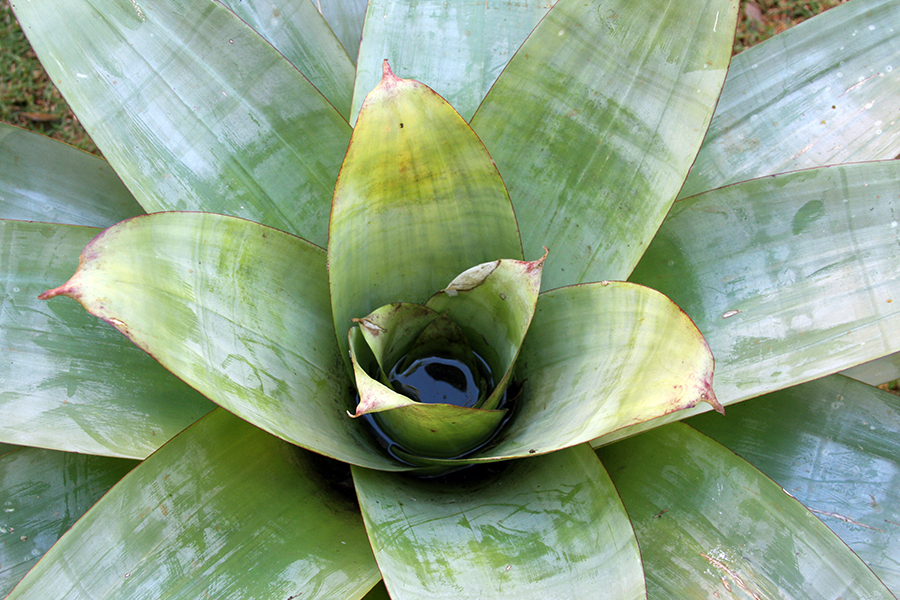Worried About Mosquitos? Drain Your Bromeliads

Mosquito-borne illnesses are on the rise, but you can help protect yourself by making sure a common South Florida plant – the bromeliad – isn’t retaining water.
According to a new study led by public health researchers at the University of Miami Miller School of Medicine, these plants contribute to breeding of the Aedes aegypti mosquito, which was a key culprit in the Zika virus outbreak that hit Miami-Dade County and other areas of Florida and the Americas in 2016.
In addition to Zika, bites from the Aedes aegypti mosquito can spread dengue, yellow fever and chikungunya.
Zika has been linked to microcephaly and other birth defects in unborn babies when pregnant women contract the disease. The family of diseases linked to the Aedes aegypti can cause other severe symptoms, and yellow fever can be fatal.
The study, published in the journal Parasites & Vectors, showed that water retained in the bromeliads’ leaf axils becomes breeding sites for mosquitoes. “In South Florida, there were older reports that bromeliads contributed to mosquito breeding, but supporting evidence was minimal,” said the study’s lead author, Dr. John Beier, a world-renowned entomologist and director of the Division of Environmental and Public Health.
Dr. Beier urged against destroying the plants but said the new knowledge on the plant’s role in mosquito breeding will help tailor mosquito control efforts.
“People should be aware that bromeliads are producing mosquitoes so that they can treat the plants,” he said.
Surprising findings
In collaboration with the Miami-Dade County Mosquito Control Division, the researchers surveyed ornamental bromeliads for the presence of immature mosquitoes at 51 locations across 11 neighborhoods in Miami-Dade, including three neighborhoods (South Beach, Little River and Wynwood) where the Zika virus was reportedly transmitted. The plants were surveyed during the summer of 2017.
Researchers drained the reservoirs of the plants and screened the water for larvae. The plants yielded a total of 765 immature mosquitoes from five species: Aedes aegypti, Wyeomyia mitchellii, Wyeomyia vanduzeei, Culex quinquefasciatus and Culex biscaynensis.
“Aedes aegypti was the most abundantly collected species, as well as the most present, contrasting with previous studies, which do not consider bromeliads as important potential breeding sites for Aedes aegypti, including for South Florida,” said study co-author Dr. Andre Barretto Bruno Wilke.
Dr. Beier added that the dominant presence of the Aedes aegypti mosquito was unexpected since the mosquito did not have as great a presence in bromeliads in prior years. As more diseases caused by the Aedes aegypti mosquito emerge, he said that more research and operational control should be focused on the highly adaptive mosquito.
“The larger problem is with the Aedes aegypti, not the disease,” he said.
The Miami-Dade County Mosquito Control Division has greatly intensified vector-mosquito suppression efforts since the Zika outbreak in 2016. UM has been a major partner in research, including mosquito mapping, surveillance and trapping. The collaboration is supported by the U.S. Centers for Disease Control and Prevention.
Similar to the sudden Zika outbreak in 2016, researchers said vector-borne diseases are spreading to new areas due to urbanization, human movement and global warming.
“Changes in the environment made by humans have a substantial impact on the ecology of mosquitoes, mainly due to a decrease in the number of species and an increase in the abundance of Aedes aegypti,” said Barretto Buno Wilke. “As a result, Aedes agypti becomes more present and can be found in greater numbers.”
Kai Hill is the manager of communications at the University of Miami Health System and the Miller School of Medicine.
Tags: Dr. John Beier, mosquitos, vector-borne illnesses, Zika
